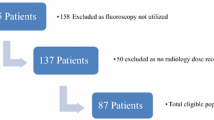Abstract
Purpose
This prospective study was performed to compare the accuracy of femoral version measurements following repair of femoral shaft fractures using computed tomography (CT) scanograms with 10 % of the standard dose of ionizing radiation versus standard-dose scanograms.
Methods
CT scanogram protocols that used 90 and 10 % of the usual dose of ionizing radiation were developed. Ten patients with comminuted femoral shaft fractures repaired with either an intramedullary (IM) nail or plate were imaged with both high- and low-dose CT scanograms. Postoperative version of both femurs was measured and compared between the two dose scans using the Bonesetter application. This was a prospective blinded controlled study at a level 1 trauma centre. Statistical analysis was performed, including standard deviation (SD) and paired t test. Significance was set at p < 0.05.
Results
Comparison of femoral version measurements between the 90 and 10 % dose scanograms on the native and repaired sides were insignificant (p = 0.870 and p = 0.737, respectively). The difference between native and repaired femurs had an average error of 2.0 ± 1.1° for both the high- and low-dose scans and was insignificant (p = 0.742).
Conclusions
Reducing the dose of ionizing radiation in a CT scanogram by 90 % has no significant effect on the accuracy of femoral version measurement. This simple change can significantly reduce patient radiation exposure while accurately measuring femoral version and length.




Similar content being viewed by others
References
Winquist RA, Hansen ST Jr, Clawson DK (1984) Closed intramedullary nailing of femoral fractures: a report of five hundred and twenty cases. J Bone Joint Surg Am 83(12):1912
Ricci WM, Bellabarba C, Lewis R et al (2001) Angular malalignment after intramedullary nailing of femoral shaft fractures. J Orthop Trauma 15(2):90–95. doi:10.1097/00005131-200102000-00003
Tornetta P, Ritz G, Kantor A (1995) Femoral torsion after interlocked nailing of unstable femoral fractures. J Trauma 38(2):213–219. doi:10.1097/00005373-199502000-00011
Jaarsma RL, Ongkiehong BF, Gruneberg C et al (2004) Compensation for rotational malalignment after intramedullary nailing for femoral shaft fractures: an analysis by plantar pressure measurements during gait. Injury 35(12):1270–1278. doi:10.1016/j.injury.2004.01.016
Jaarsma RL, Pavkis DM, Verdenschot N et al (2004) Rotational malalignment for intramedullary nailing of femoral fractures. J Orthop Trauma 18(7):403–409. doi:10.1097/00005131-200408000-00002
Wiss DA, Fleming CH, Matta JM (1986) Comminuted and rotationally unstable fractures of the femur treated with an interlocking nail. Clin Orthop Relat Res 212:35–47
Braten M, Terjesen T, Rossvoll I (1993) Torsional deformity after intramedullary nailing of femoral shaft fractures: measurement of anteversion angles in 110 patients. J Bone Joint Surg (Br) 75(5):799–803
Ayalon OB, Patel NM, Yoon RS et al (2014) Comparing femoral version after intramedullary nailing performed by trauma-trained and non-trauma trained surgeons: is there a difference? Injury 45(7):1091–1094. doi:10.1016/j.injury.2014.01.024
Patel NM, Yoon RS, Cantlon MB et al (2014) Intramedullary nailing of diaphyseal femur fractures secondary to gunshot wounds: predictors of postoperative malrotation. J Orthop Trauma 28(12):711–714. doi:10.1097/BOT.0000000000000124
Hufner T, Citak M, Suero E et al (2011) Femoral malrotation after unreamed intramedullary nailing: an evaluation of influencing operative factors. J Orthop Trauma 25(4):224–227. doi:10.1097/BOT.0b013e3181e47e3b
Salem KH, Maier D, Keppler P et al (2006) Limb malalignment and functional outcome after antegrade versus retrograde intramedullary nailing in distal femoral fractures. J Trauma 61(2):375–381
Vaidya R, Anderson B, Elbanna A et al (2012) CT scanogram for limb length discrepancy in comminuted femoral shaft fractures following IM nailing. Injury 43(7):1176–1181. doi:10.1016/j.injury.2012.03.022
Espinoza C, Sathy A, Moore D et al (2014) Use of inherent anteversion of an intramedullary nail to avoid malrotation in femur fractures. J Orthop Trauma 28(2):e34–e38. doi:10.1097/BOT.0b013e318298e48c
Hirata M, Nakashima Y, Itokawa T et al (2014) Influencing factors for the increased stem version compared to the native femur in cementless total hip arthroplasty. Int Orthop 38(7):1341–1346. doi:10.1007/s00264-014-2289-y
Fujishiro T, Hayashi S, Kanzaki N et al (2014) Computed tomographic measurement of acetabular and femoral component version in total hip arthroplasty. Int Orthop 38(5):941–946. doi:10.1007/s00264-013-2264-z
Goldman LW (2007) Principles of CT: radiation dose and image quality. J Nucl Med Technol 35(4):213–225. doi:10.2967/jnmt.106.037846
Chauhan SK, Clark GW, Lloyd S et al (2004) Computer-assisted total knee replacement: a controlled cadaver study using a multi-parameter quantitative CT assessment of alignment (the Perth CT protocol). J Bone Joint Surg (Br) 86(6):818–823. doi:10.1302/0301-620X.86B6.15456
Mettler FA Jr, Huda W, Yoshizumi TT, Mahesh M (2008) Effective doses in radiology and diagnostic nuclear medicine: a catalog. Radiology 248(1):254–263. doi:10.1148/radiol.2481071451
Biswas D, Bible JE, Bohan M et al (2009) Radiation exposure from musculoskeletal computerized tomographic scans. J Bone Joint Surg Am 91(8):1882–1889. doi:10.2106/JBJS.H.01199
Watson SJ, Jones AL, Oatway WB, Hughes JS (2005) Ionizing radiation exposure of the UK population: 2005 Review. Health Protection Agency. HPA-RPD-001. http:// www.hpa.org.uk/radiation/publications/hpa_rpd_reports/2005/hpa_rpd_001.htm
Author information
Authors and Affiliations
Corresponding author
Ethics declarations
Conflicts of interest
The authors have no conflicts of interest to declare.
Ethical approval
All procedures performed in studies involving human participants were in accordance with the ethical standards of the institutional and/or national research committee and with the 1964 Declaration of Helsinki and its later amendments or comparable ethical standards.
Informed consent
Informed consent was obtained from all individual participants included in the study.
Rights and permissions
About this article
Cite this article
Hultman, K.L., Vaidya, R., Malkawi, I. et al. Accuracy of Low Dose Computed Tomography Scanogram for Measurement of Femoral Version after Locked Intramedullary Nailing. International Orthopaedics (SICOT) 40, 1955–1960 (2016). https://doi.org/10.1007/s00264-015-3040-z
Received:
Accepted:
Published:
Issue Date:
DOI: https://doi.org/10.1007/s00264-015-3040-z




